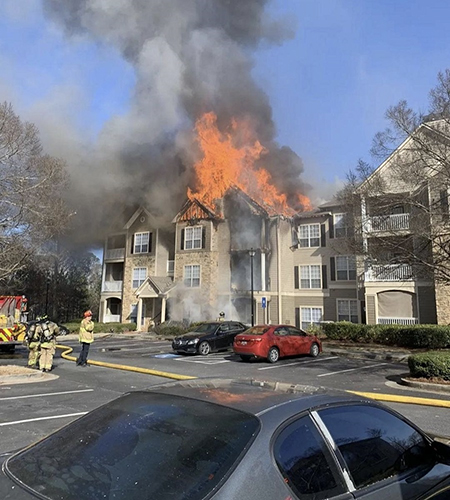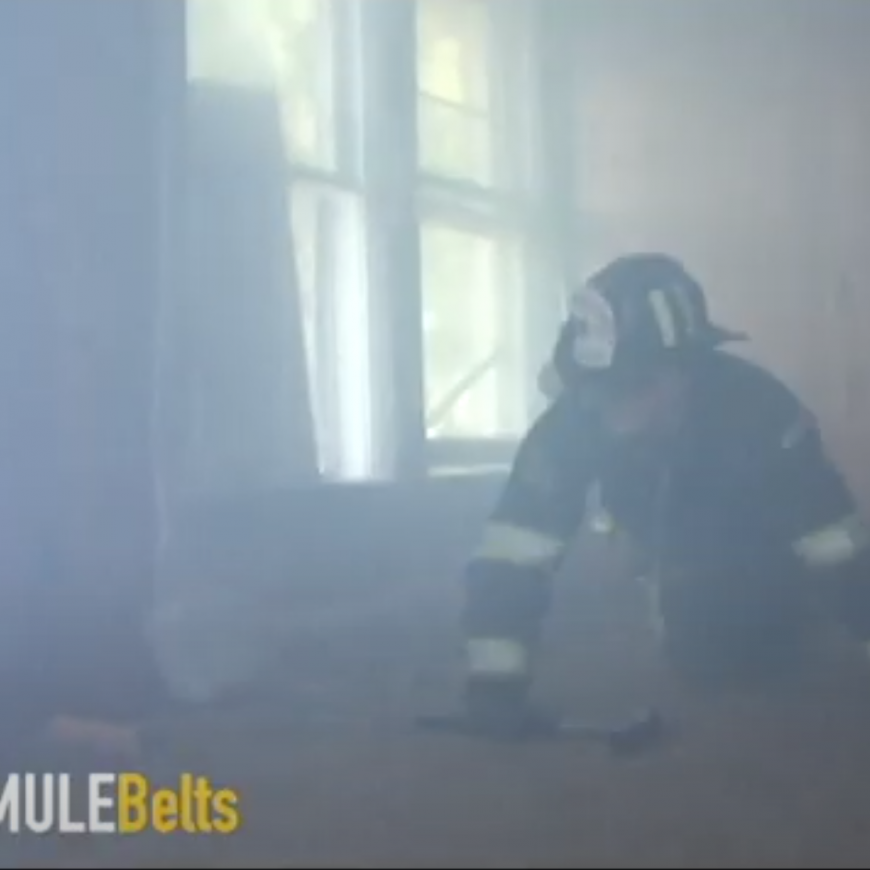Training Notebook ❘ By ZACHARY BROWN
Garden-style apartments have become almost a regular sight throughout the modern landscape. With the influx of the populace now occupying cities and the suburbs, garden-style apartments provide relatively cheap housing and allow developers to capitalize on limited space to bring in maximum capital. With the recent housing market boom, apartment living that was once mostly limited to young professionals and low-income families has become commonplace, even in the richest suburbs, where middle class families and even retired couples reside.
- Garden Apartment Fires: No Walk in the Park
- FIREGROUND SIZE-UP FOR GARDEN APARTMENTS AND TOWNHOUSES
- Simulation: Four-Story Garden Apartment Fire
- Concealed Spaces and Fire Spread
Francis Brannagan’s book Brannigan’s Building Construction for the Fire Service defines a garden-style apartment as a multifamily building made up of combustible materials, where apartments are contained to one story. Other definitions describe the garden-style apartment as a low-rise building, typically one to four stories, that has outside grounds or a “garden” for tenants and the top floors are accessible by stair only. They typically have anywhere from four to 12 units per floor and, depending on the apartment building, can range from 600-square-foot one-bedroom units to 1,600-square-foot three-bedroom units. They are almost always constructed of combustible materials and have large numbers of void spaces throughout.

(1) The first-arriving unit found heavy fire autoexposing from a balcony into the soffit and attic. Without a firewall, the fire has the potential to spread very quickly. (Photos by author.)
Many of these buildings have long common attics and open-trussed floor systems that can act like a horizontal balloon-frame building, allowing quick-moving horizontal fire spread from one side of the building to the other. This can result in fast-moving fire conditions that can easily outpace even the best fire companies if they are not prepared. Some garden apartments have sprinklers mounted in the void spaces between floors or in attics, which is not a National Fire Protection Association 13, Standard for the Installation of Sprinkler Systems, requirement, so many builders forgo these amenities to save on money and materials. It is important to be cognizant that, with open void spaces, there is ample opportunity for fire spread with little to nothing showing on arrival. Thus, don’t let down your guard if you don’t see much or you are en route and the first-arriving officer states that there is nothing showing. Rather, do an in-depth size-up and be ready for deep-seated fire that may not have shown itself yet.
On Arrival
On arrival to fires in garden apartments, the first-arriving officer needs to quickly determine the location of the fire and its path of travel. It is a mistake to treat these buildings like single-family residences. Although the building construction is often the same as that of a single-family dwelling, it is critical to understand that these buildings require different tactics.
Once the first-arriving officer determines the location of the fire, he must relay this to his and incoming crews as well as the tactics that he plans to implement. As with all fires, the first priority is life safety. Depending on the size of the first company, they may be able to accomplish this along with getting lines into place. However, you may need to accomplish this assignment immediately in case of an immediate life hazard or delegate it to one of the next incoming crews. Either way, it should be performed as early in the incident as possible. Every apartment in the building needs to be cleared if the occupants answer the door or searched to ensure that all civilians are out of each apartment in the building.
If the fire is in an individual apartment, it often can be extinguished quickly as long as the stretch is not miscalculated and crews can get water on it before it breaches the attic, the floor system, or another unit. However, fires that have accessed the attic prior to our arrival or are in the process of autoexposing from an apartment or apartment balcony through the soffit or siding into the attic space have the potential to do the most harm and are the hardest to handle.
We can employ some tactics to give us a leg up in controlling these fires. The first is a “blitz attack,” which is performed by using the engine-mounted deck gun that can shoot 500 to 1,000-plus gallons per minute (gpm) at a fire that is in the process of autoexposing into the attic. Most modern engines or pumpers carry 500 to 1,000 gallons of water in their booster tanks. By dumping that water directly onto the fire, we stand a good chance of stopping it before it gets a running start in the attic or, at the very least, stopping it enough to give us time to deploy a line up the stairs and to the seat of the fire.
There is some risk associated with this attack. You are dumping your entire booster tank onto the fire, and another engine has to come and give you their water or you will need to establish a positive water supply quickly to continue the attack with handlines. However, with training, crews should become competent on deck gun application, putting water in the right place, and getting additional water to the attack engine quickly while crews are stretching up the stairs.
The Attic and Cockloft
You could call the attic or cockloft the “heart” of the garden apartment. If fire gets a “running start” in the attic, it is as if someone has shot an arrow into the heart of the building, and it often proves to be a fatal blow, hence the need to determine quickly where the fire is and, if possible, to cut it off just as quickly with a blitz attack. Or, if the fire already has a foothold in the attic space, a flank attack or getting ahead of the fire may be the next best option.
Attic spaces in garden apartments may or may not have a firewall that divides the building up into smaller, more manageable sections, and they can stop encroaching fire. If a firewall is in place, it can be made up of concrete or, many times in newer apartments, gypsum board that is doubled up, in theory holding up fire for two hours. Although the concrete firewall stands up fairly well to fire, doubled gypsum board often fails rather quickly with a hot and fast-moving fire. Also, the firewall is often breached by contractors prior to the event as they cut large holes to pass plumbing and wiring conduits through the firewall from one side to the next. Thus, unless an obvious concrete firewall is present and identified and if fire has breached and is running in the attic, plan on having to move ahead of the fire to stop it.
Although our natural instinct is to stretch hose to where the fire is presenting itself on arrival, the incident commander needs to have the forethought as to where the fire is moving as well as the discipline to move ahead and cut it off. This may be that the area where the fire is currently is abandoned and even written off, and crews will stretch large-diameter hoselines (LDH) ahead of the fire. Once ahead, crews must open the gypsum board on the top floor to gain access to the attic and then plan to stand their ground as the fire advances toward them. The best option for this tactic may be entering apartments to gain access to the attic; there will only be gypsum board instead of plywood or even thin sheet metal that comprises the ceilings of most breezeways. Use this tactic only if it’s absolutely clear that firefighters are well outside of the truss collapse zone.

(2) Nighttime fires in garden apartments have the potential for high loss of life. Evacuation, search, and extinguishment need to be early priorities.
Once in the attic, crews need to direct their hose streams on the encroaching fire, aiming high toward the roof and allowing the water droplets to fall and cool the burning wood truss surfaces. Depending on your local standard operating guidelines, if allowed, it may be advantageous to use a two-pronged attack using master streams or prepiped aerial ladders to attack the fire at the point of origin that was originally written off in conjunction with an offensive attack ahead of the fire. We may not always be able to win the battle or the war, but sometimes it’s necessary to lose part of the building to save another part of it.
Big fire requires big water, regardless of whether you are using an interior offensive attack, an exterior defensive attack, or a both. Garden apartments with advancing fire will require big water with lots of gpm. This can be in the form of LDH such as a 2½-inch hoseline delivering 265 to 365 gpm, depending on your tip size, or an aerial master stream that can deliver gpm in the thousands.
Although several formulas give us an exact amount of gpm per British thermal units, formulas are often unreliable, as conditions on scene are constantly changing, and it is difficult to formulate factors that are changing rapidly and that we may not be able to gather all the data on. Rather, I’ve found that its much easier to rely on experience and training in knowing when to implement certain tactics, such as LDH, that can provide larger gpm. Depending on your water supply, it may be advantageous to have multiple tankers en route or lay out from a hydrant that may be farther but can provide more water. At the beginning of the incident, think ahead regarding what you might need if the fire outruns crews instead of having to audible midway through the incident.
When dispatched to a possible fire at a garden-style apartment, it is essential to do a thorough 360° size-up, evaluating the building and the conditions on arrival. If nothing is showing or there only light smoke showing, don’t let down your guard; be vigilant to determine if there is hidden fire running in an open space. Also, determine where the fire is located and where it is headed. Life safety and evacuation of tenants is always first priority. If the fire is in the process of autoexposing into the attic, a blitz attack, although risky, may be necessary to stop the fire in its tracks long enough to get handlines into place. If, however the fire is already in the attic or running the top floor, a flank attack and getting ahead of the fire may be our next best option.
Remember, this isn’t a single-family dwelling that is burning but rather a large building and, depending on how large, the fire has grown prior to arrival and could require a lot of water. Make an educated decision that considers the fire’s location, size, and movement before implementing your tactics. Fires in garden-style apartments shouldn’t be overwhelming if you train before the fire and are ready to implement the correct tactics for the building when it’s time to do so.
Read More: https://www.fireengineering.com/firefighter-training/sizing-up-garden-style-apartment-fires/
Contact PacMule Belts at 630-868-3877 or click here



